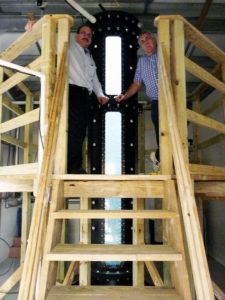Mesocosm Experiments Look at Oil Spills from the Bottom Up
– March 12, 2015
(From Winter 2015 Newsletter) Scientists have simulated a variety of deep-sea oil spill conditions in miniature via a pair of mesocosms, an approach that bridges traditional laboratory and in situ observations.
A large team of researchers from the Dispersion Research on Oil: Physics and Plankton Studies (DROPPS) consortium have built two tanks (each representing a different timeframe in the spill) to bring relevant components of the Gulf of Mexico into the lab. They intend to observe how oil rises and disperses upon entering the environment and how it interacts with small planktonic organisms once there.
The scientists created two four-meter-tall tanks, each configured with different oil injection systems to simulate different phases of a deep water spill. They designed both tanks at Johns Hopkins University (JHU) with parts built to specifications in Baltimore. The first tank was sent to The University of Texas Marine Science Institute (UTMSI) and took several months to be correctly manufactured and assembled, becoming operational this past spring.
The UTMSI tank simulates the later stage of a spill, when oil encounters native marine plankton in the water column. The bottom of the tank contains heavier, more saline water, with slightly less dense, less saline water in the top half. The scientists insert planktonic diatoms through a port in the side of the tank, and the interface between the two densities suspends them initially in the top layer. They then introduce crude oil, with and without dispersant, slowly through a wide, flat shower head at the bottom, creating a cloud of oil that researchers can observe rising through the planktonic layer.
DROPPS Director Dr. Ed Buskey explains that with the cameras, “We can observe oil droplets rising through this layer of plankton and see how they interact. This helps us answer questions such as, what fraction of the diatoms will be carried up the water column with the rising oil droplets? Will oil droplets collect diatoms and eventually sink?”
These mesocosm experiments allow an interdisciplinary team with expertise in plankton ecology, chemistry, and fluid dynamics to come together to ask questions about how oil moves and interacts in the environment. The team’s findings will help responders work more quickly and accurately to protect people and the environment in a future spill.
To learn more about the experiments and see a diagram of the Mesocom tanks in action, check out the full story on GoMRI’s website here: https://gulfresearchinitiative.org/mesocosm-experiments-look-oil-spill-bottom/.







